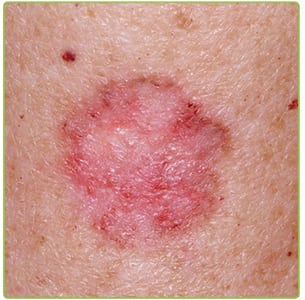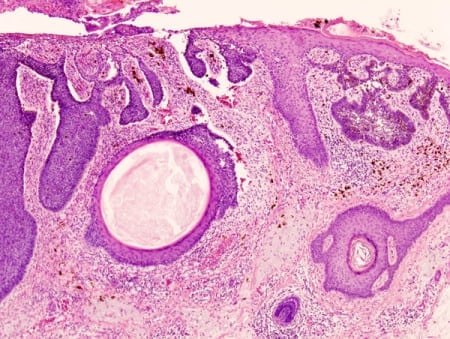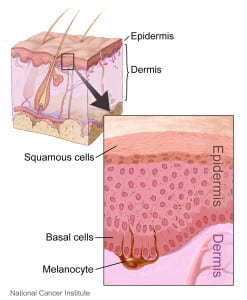What is Basal Cell Carcinoma?
Posted on August 3, 2015 in Skin Cancer
Skin Cancer 101: What is Basal Cell Carcinoma?
Written By: SERO Board-Certified Physicians
Basal cell carcinoma (BCC) is the most common form of skin cancer.
Basal cell carcinoma (BCC) is a form of skin cancer that develops in the top layer of the skin. It is by far the most common type of skin cancer—of the 3.5 million cases of skin cancer diagnosed every year in the United States, nearly 80% are basal cell carcinomas.
What are basal cells?
Human skin is made up of two main layers: the epidermis, which forms the top layer of skin, and the dermis, which forms the bottom layer.
The epidermis functions as the protective outer shell, while the dermis contains blood vessels, hair follicles, melanocytes, and other specialized biological structures.
Within the two layers of skin, several different types of cells can be found. Each type of cell serves a different role in the normal functioning of the skin.
Basal cells can be found in the deepest layer of the epidermis. While their specific purpose isn’t completely clear, scientist believe basal cells serve as a type of stem cell—basal cells start out as relatively undifferentiated, but rapidly reproduce and aid in the process of creating new skin cells.
What are basal cell carcinomas?
 Basal cell carcinomas are cancerous lesions or tumors that are made up of damaged or mutated basal cells. These tumors form in the outer layer of the skin, and appear as small bumps or sores. BCCs rarely spread beyond the original location of the cancer.
Basal cell carcinomas are cancerous lesions or tumors that are made up of damaged or mutated basal cells. These tumors form in the outer layer of the skin, and appear as small bumps or sores. BCCs rarely spread beyond the original location of the cancer.
Like all forms of cancer, basal cell carcinomas are the result of damage to the DNA of the cell. When a cell is damaged in certain ways, its DNA mutates, which can cause the cell to reproduce in an abnormal, uncontrolled way. Unregulated cell growth causes the formation of cancerous lesions or tumors.
While BCCs may form anywhere on the body, the most often appear on areas that are regularly exposed to the sun, such as the arms, neck, and face.
Warning Signs
Basal cell carcinoma is highly curable when discovered and treated in its early stages and almost never spreads to other areas of the body or becomes life-threatening. However, BCCs can be disfiguring and lead to dangerous complications if not treated promptly.
Basal cell carcinomas may appear as:
- An open sore that frequently fails to heal and bleeds, oozes, or crusts for multiple weeks at a time.
- An irritated patch that may be red in color and itchy or sensitive to touch.
- A slick red, white, or pink bump with a pearly finish.
- A pink growth that contains a crusty center surrounded by an elevated pink ring; enlargement of the ring sometimes results in appearance of tiny blood vessels on the skin’s surface.
- A scar-like area that may be white, yellow, or waxy with irregular and poorly-defined borders; this specific warning sign may indicate that the cancer is larger than one might expect.
Causes of BCC
The main causes of basal cell carcinoma:
- The combination of long-term sun exposure and extended, intense sun exposure (resulting in sunburn)
- Contact with arsenic
- Exposure to radiation
- Open sores that don’t heal
- Inflammatory skin conditions
- Potential complications of burns, tattoos, scars, infections, or vaccinations
Risk Factors for BCC
In regards to cancer, “risks factors” are characteristics or traits that may make a person more likely to develop cancer. Many risk factors are associated with basal cell carcinoma, ranging from hair color and skin tone to family history.
Below are some of the characteristics that indicate a higher risk of developing the cancer:
- Fair skin
- Blond hair
- Light-colored eyes
- Family history of BCC
- Previously having BCC, specifically on the nose or scalp
Treatment Options
If you are diagnosed with BCC, you have many excellent treatment options to choose from. Each option has shown high rates of success.
BCC treatment options include:
- Curettage and Electrodessication
- Generally performed on smaller lesions; lesions are scraped off with an instrument with a sharp, ring-shaped tip (a curette), and the tumor is burned.
- Radiation therapy
- Radiation oncologists, such as those at SERO, utilize radiation therapy to completely eradicate the tumor over the course of several weeks of radiation treatments. Radiation is ideal for elderly patients or those who are not candidates for surgical excision.
- Cryosurgery-liquid nitrogen
- Liquid nitrogen is applied to the tumor tissue to freeze and destroy lesions.







